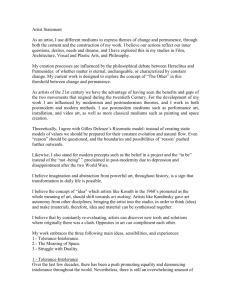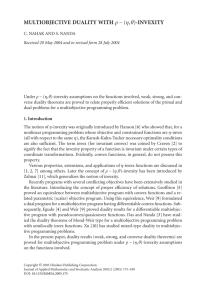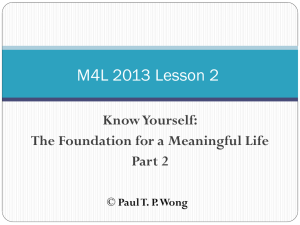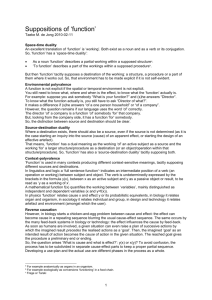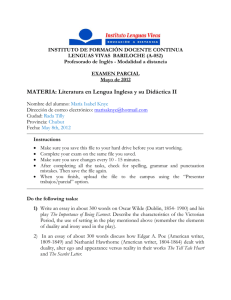Document 10942682
advertisement
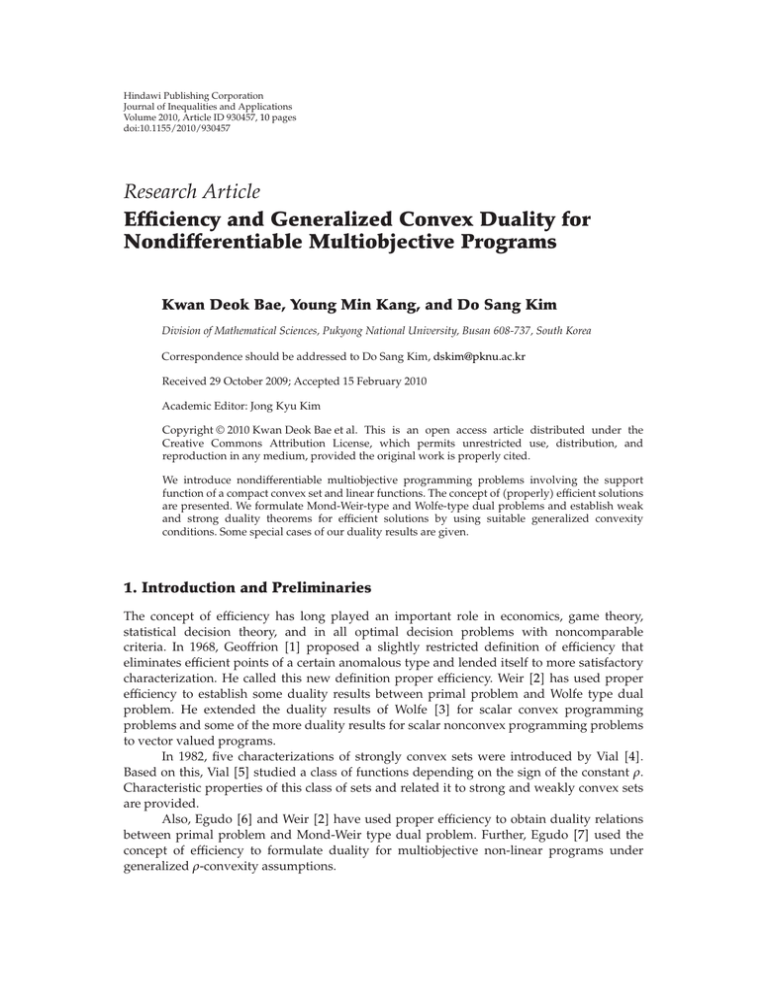
Hindawi Publishing Corporation
Journal of Inequalities and Applications
Volume 2010, Article ID 930457, 10 pages
doi:10.1155/2010/930457
Research Article
Efficiency and Generalized Convex Duality for
Nondifferentiable Multiobjective Programs
Kwan Deok Bae, Young Min Kang, and Do Sang Kim
Division of Mathematical Sciences, Pukyong National University, Busan 608-737, South Korea
Correspondence should be addressed to Do Sang Kim, dskim@pknu.ac.kr
Received 29 October 2009; Accepted 15 February 2010
Academic Editor: Jong Kyu Kim
Copyright q 2010 Kwan Deok Bae et al. This is an open access article distributed under the
Creative Commons Attribution License, which permits unrestricted use, distribution, and
reproduction in any medium, provided the original work is properly cited.
We introduce nondifferentiable multiobjective programming problems involving the support
function of a compact convex set and linear functions. The concept of properly efficient solutions
are presented. We formulate Mond-Weir-type and Wolfe-type dual problems and establish weak
and strong duality theorems for efficient solutions by using suitable generalized convexity
conditions. Some special cases of our duality results are given.
1. Introduction and Preliminaries
The concept of efficiency has long played an important role in economics, game theory,
statistical decision theory, and in all optimal decision problems with noncomparable
criteria. In 1968, Geoffrion 1 proposed a slightly restricted definition of efficiency that
eliminates efficient points of a certain anomalous type and lended itself to more satisfactory
characterization. He called this new definition proper efficiency. Weir 2 has used proper
efficiency to establish some duality results between primal problem and Wolfe type dual
problem. He extended the duality results of Wolfe 3 for scalar convex programming
problems and some of the more duality results for scalar nonconvex programming problems
to vector valued programs.
In 1982, five characterizations of strongly convex sets were introduced by Vial 4.
Based on this, Vial 5 studied a class of functions depending on the sign of the constant ρ.
Characteristic properties of this class of sets and related it to strong and weakly convex sets
are provided.
Also, Egudo 6 and Weir 2 have used proper efficiency to obtain duality relations
between primal problem and Mond-Weir type dual problem. Further, Egudo 7 used the
concept of efficiency to formulate duality for multiobjective non-linear programs under
generalized ρ-convexity assumptions.
2
Journal of Inequalities and Applications
Duality theorems for nondifferentiable programming problem with a square root
term were obtained by Lal et al. 8. In 1996, Mond and Schechter 9 studied duality
and optimality for nondifferentiable multiobjective programming problems in which each
component of the objective function contains the support functions of a compact convex sets.
And Kuk et al. 10 defined the concept of V, ρ-invexity for vector-valued functions, which
is a generalization of the concept of V -invexity concept.
Recently, Yang et al. 11 introduced a class of nondifferentiable multiobjective
programming problems involving the support functions of compact convex sets. They
established only weak duality theorems for efficient solutions. Subsequently, Kim and Bae
12 formulated nondifferentiable multiobjective programs involving the support functions
of a compact convex sets and linear functions.
In this paper, we introduce generalized convex duality for nondifferentiable multiobjective program for efficient solutions. In Section 2 and Section 3, we formulate MondWeir type dual and Wolfe type dual problems and establish weak and strong duality under
ρ-convexity assumptions. In addition, we obtain some special cases of our duality results in
Section 4. Our duality results extend and improve well known duality results.
We consider the following multiobjective programming problem:
minimize
f1 x sx | C1 , . . . , fp x s x | Cp
subject to gj x 0,
hl x 0,
VOPE
j 1, . . . , m,
l 1, . . . , q.
The functions fi : Rn → R, i 1, . . . , p, gj : Rn → R, j 1, . . . , m and hl : Rn → R, l 1, . . . , q are assumed to be differentiable. And Ci , for each i ∈ P {1, 2, . . . , p}, is a compact
convex set of Rn .
Definition 1.1. A feasible solution x0 for VOPE is efficient for VOPE if and only if there is
no other feasible x for VOPE such that
fi x sx | Ci < fi x0 s x0 | Ci
for some i ∈ P,
fi0 x sx | Ci0 fi0 x0 s x0 | Ci0
1.1
∀i0 ∈ P.
Definition 1.2. Let C be a compact convex set in IRn . The support function sx | C is defined
by
sx | C : max xT y : y ∈ C .
1.2
The support function sx | C, being convex and everywhere finite, has a subdifferential, that
is, there exists z such that
s y | C ≥ sx | C zT y − x
∀y ∈ C.
1.3
Journal of Inequalities and Applications
3
Equivalently,
zT x sx | C.
1.4
The subdifferential of sx | C is given by
∂sx | C : z ∈ C : zT x sx | C .
1.5
The following definition of ρ-convex function will be used to prove weak duality
theorems in Section 2 and Section 3.
Definition 1.3 see 4, 5. A function fi : Rn → R is said to be ρi -convex if there exists a real
number ρi such that for each x, u ∈ Rn and 0 λi 1,
fi λi x 1 − λi u λi fi x 1 − λi fi u − ρi λi 1 − λi x − u2 .
1.6
For a differentiable function fi : Rn → R, fi is ρi -convex if and only if for all x, u ∈ Rn ,
fi x − fi u x − uT ∇fi u ρi x − u2 .
1.7
If ρi is positive then fi is said to be strongly convex 4 and if ρi is negative then fi is
said to be weakly convex 5.
In this paper, the proofs of strong duality theorems will invoke the following.
Lemma 1.4. (Chankong and Haimes [13, Theorem 4.1]) x0 is an efficient solution for VOPE if and
only if x0 solves the following:
Pk 0
for each k 1, . . . , p.
minimize
fk x sx | Ck subject to
fi x sx | Ci fi x0 s x0 | Ci ,
gj x 0,
j 1, . . . , m,
hl x 0,
l 1, . . . , q
∀i / k,
1.8
4
Journal of Inequalities and Applications
2. Mond-Weir-Type Duality
We introduce a Mond-Weir type dual programming problem and establish weak and strong
duality theorems.
Maximize
fu uT w f1 u uT w1 , . . . , fp u uT wp
MVODE
subject to
p
τi ∇fi u wi ∇yT gu ∇zT hu 0,
2.1
i1
yT gu zT hu 0,
yj 0,
τi 0,
j 1, . . . , m, wi ∈ Ci , i 1, . . . , p,
2.2
p
τi 1.
i 1, . . . , p,
i1
Theorem 2.1 Weak Duality. Assume that for all feasible x for VOPE and all feasible
u, τ, w, y, z for MVODE, fi · ·T wi , i 1, . . . , p, are ρi −convex, gj ·, j 1, . . . , m, are
σj -convex and hl ·, l 1, . . . , q, are affine. If also any of the following conditions holds
p
a τi > 0, forall i ∈ P and i1 τi ρi m
j1 yj σj 0;
p
m
b i1 τi ρi j1 yj σj > 0,
then the following cannot hold:
fi x sx | Ci < fi u uT wi ,
for some i ∈ P
fi0 x sx | Ci0 fi0 u uT wi0 ,
∀i0 ∈ P.
2.3
Proof. Suppose contrary to the result that 2.3 hold; then for τi > 0 for each i 1, . . . , p, 2.3
imply
p
p
τi fi x sx | Ci <
τi fi u uT wi
i1
for some i ∈ P
2.4
i1
and for τi 0, i 1, . . . , p, 2.3 imply
p
p
τi fi0 x sx | Ci0 τi fi0 u uT wi0
i1
∀i0 ∈ P.
2.5
i1
Since xT wi sx | Ci , i 1, . . . , p, then 2.4 and 2.5 imply
p
p
τi fi x xT wi <
τi fi u uT wi ,
i1
i1
p
p
τi fi0 x xT wi0 τi fi0 u uT wi0 .
i1
i1
2.6
Journal of Inequalities and Applications
5
From ρi -convexity of fi · ·T wi , i 1, . . . , p, we have
p
p
τi ∇fi u wi
τi ρi x − u2 < 0
x − u
T
i1
for some i ∈ P,
2.7
i1
p
p
τi ∇fi0 u wi0
τi ρi x − u2 0 ∀i0 ∈ P
x − u
T
i1
2.8
i1
respectively. Also, since u, τ, w, y, z is feasible for MVODE and x is feasible for VOPE,
we have
⎞ ⎛
⎞
q
q
m
m
⎝ yj gj x zl hl x⎠ − ⎝ yj gj u zl hl u⎠ 0.
⎛
j1
j1
l1
2.9
l1
Since gj ·, j 1, . . . , m are σj -convex and hl ·, l 1, . . . , q are affine, then 2.9 imply
⎞ ⎛
⎞
q
m
m
x − uT ⎝ yj ∇gj u zl ∇hl u⎠ ⎝ yj σj ⎠x − u2 0.
⎛
j1
2.10
j1
l1
Adding 2.7, 2.10 and then applying hypothesis a, we get
⎞
⎛
p
q
m
τi ∇fi u wi yj ∇gj u zl ∇hl u⎠ < 0,
x − u
T⎝
i1
j1
2.11
l1
which contradicts 2.1. Also, adding 2.8 and 2.10 and then applying hypothesis b, we
get 2.11. This contradicts to 2.1. Hence 2.3 cannot hold.
It is easy to derive the following result from the corresponding one by Egudo 7.
Corollary 2.2. Assume that the conclusion of Theorem 2.1 holds between VOPE and MVODE. If
u0 , τ 0 , w0 , y0 , z0 is feasible for MVODE such that u0 is feasible for VOPE and u0T wi0 su0 |
Ci , i 1, . . . , p, then u0 is efficient for VOPE and u0 , τ 0 , w0 , y0 , z0 is efficient for MVODE.
Theorem 2.3 Strong Duality. If x0 be efficient for VOPE and assume that x0 satisfies a
constraint qualification [14, pages 102-103] for 1.8 for at least one k 1, . . . , p. Then there exist
τ 0 ∈ Rp , y0 ∈ Rm , z0 ∈ Rq and wi0 ∈ Ci , i 1, . . . , p such that x0 , τ 0 , w0 , y0 , z0 is feasible for
T
MVODE and x0 wi0 sx0 | Ci , i 1, . . . , p. If also weak duality (Theorem 2.1) holds between
VOPE and MVODE, then x0 , τ 0 , w0 , y0 , z0 is efficient for MVODE.
6
Journal of Inequalities and Applications
Proof. Since x0 is an efficient solution of VOPE, by Lemma 1.4, x0 solves 1.8 for each k 1, . . . , p. By hypothesis there exists at least one k 1, . . . , p such that x0 satisfies a constraint
qualification 14, pages 102,103 for 1.8. From the Kuhn-Tucker necessary conditions 14,
0
we obtain τi 0 for all i / k, 0 y ∈ Rm , z ∈ Rq and wi ∈ Ci , i 1, . . . , p such that
q
m
∇fk x0 wk τi ∇fi x0 wi yj ∇gj x0 zl ∇hl x0 0,
j1
i/
k
wiT x0 s x0 | Ci ,
l1
i 1, . . . , p,
2.13
m
yj gj x0 0.
2.14
j1
Now dividing 2.12 and 2.14 by 1 τk0 1
y 0
1
1
i/
k τi
y
i/
k
i/
k
τi and defining
> 0,
τi
2.12
0,
τi0 1
z 0
τ
i
1
i/
k
z
τi
i/
k
0,
2.15
τi
,
we conclude that x0 , τ 0 , w0 , y0 , z0 is feasible for MVODE. The efficiency of
x0 , τ 0 , w0 , y0 , z0 for MVODE now follows from Corollary 2.2.
3. Wolfe Type Duality
We introduce a Wolfe type dual programming problem and establish weak and strong duality
theorems.
Maximize
fu uT w yT gu e zT hu e
f1 u uT w1 yT gu zT hu, . . . , fp u uT wp yT gu zT hu
WVODE
subject to
p
τi ∇fi u wi ∇yT gu ∇zT hu 0,
3.1
i1
yj 0,
j 1, . . . , m, wi ∈ Ci , i 1, . . . , p,
τi 0,
i 1, . . . , p,
p
i1
τi 1.
3.2
Journal of Inequalities and Applications
7
Theorem 3.1 Weak Duality. Assume that for all feasible x for VOPE and all feasible
u, τ, w, y, z for WVODE, fi · ·T wi , i 1, . . . , p, are ρi -convex, gj ·, j 1, . . . , m, are
σj −convex and hl ·, l 1, . . . , q, are affine. If also any of the following conditions holds:
a τi > 0, forall i ∈ P and
a
p
i1 τi ρi
m
j1
p
i1 τi ρi
m
j1
yj σj 0;
yj σj > 0,
then the following cannot hold:
fi x sx | Ci < fi u uT wi yT gu zT hu,
for some i ∈ P,
fi0 x sx | Ci0 fi0 u uT wi0 yT gu zT hu,
3.3
∀i0 ∈ P.
Proof. Suppose contrary to the result that 3.3 hold. Then since x is feasible for VOPE and
0 y ∈ Rm , z ∈ Rq , 3.3 imply
fi x sx | Ci yT gx zT hx < fi u uT wi yT gu zT hu,
for some i ∈ P,
fi0 x sx | Ci0 yT gx zT hx fi0 u uT wi0 yT gu zT hu,
∀i0 ∈ P.
3.4
Since xT wi sx | Ci , i 1, . . . , p, 3.4 yield
fi x xT wi yT gx zT hx < fi u uT wi yT gu zT hu,
for some i ∈ P
fi0 x xT wi0 yT gx zT hx fi0 u uT wi0 yT gu zT hu,
∀i0 ∈ P.
3.5
Now if hypothesis a holds, then from τi > 0 for all i ∈ P , 3.5 we obtain
p
p
p
τi fi x xT wi yT gx τi zT hx τi
i1
i1
i1
p
p
p
<
τi fi u uT wi yT gu τi zT hu τi ,
i1
and since
p
i1 τi
i1
i1
1, this inequality reduces to
p
τi fi x xT wi − fi u − uT wi yT gx zT hx − yT gu − zT hu < 0.
i1
3.6
3.7
8
Journal of Inequalities and Applications
Now from 3.7, ρi -convexity of fi · ·T wi , i 1, . . . , p, σj -convexity of gj ·, j 1, . . . , m
and hl ·, l 1, . . . , q, is affine, we obtain
⎞
⎛ p
p
m
T
T
τi ∇fi u wi ∇y gu ∇z hu ⎝ τi ρi yj σj ⎠x − u2 < 0
x − u
T
i1
i1
j1
3.8
and since by hypothesis a,
p
i1 τi ρi
m
j1
yj σj 0, this implies
p
T
T
τi ∇fi u wi ∇y gu ∇z hu < 0
x − u
T
3.9
i1
which contradicts 3.1. Also from 3.5, τi 0, i 1, . . . , p, and
p
i1 τi
1, we obtain
p
τi fi x xT wi − fi u − uT wi yT gx zT hx − yT gu − zT hu 0,
3.10
i1
and since fi · ·T wi , i 1, · · · , p, are ρi -convex, gj ·, j 1, . . . , m, are σj -convex and
hl ·, l 1, . . . , q, are affine, 3.10 implies
⎞
⎛ p
p
m
τi ∇fi u wi ∇yT gu ∇zT hu ⎝ τi ρi yj σj ⎠x − u2 0.
x − uT
i1
i1
j1
3.11
Now by hypothesis b,
contradicting 3.1.
p
i1 τi ρi
m
j1
yj σj
> 0, hence 3.11 implies 3.9, again
The following result can be easily driven from the corresponding one by Egudo 7.
Corollary 3.2. Assume that the conclusion of Theorem 3.1 holds between VOPE and WVODE.
If u0 , τ 0 , w0 , y0 , z0 is feasible for WVODE such that u0 is feasible for VOPE, y0T gu0 0 and
u0 T wi0 su0 | Ci , i 1, . . . , p, then u0 is efficient for VOPE and u0 , τ 0 , w0 , y0 , z0 is efficient
for WVODE.
Theorem 3.3 Strong Duality. If x0 be efficient for VOPE and assume that x0 satisfies a
constraint qualification [14, pages 102,103] for 1.8 for at least one k 1, . . . , p. Then there
exist τ 0 ∈ Rp , y0 ∈ Rm , z0 ∈ Rq and wi0 ∈ Ci , i 1, . . . , p such that x0 , τ 0 , w0 , y0 , z0 is
T
feasible for WVODE and y0 gx0 0, x0 T wi0 sx0 | Ci , i 1, . . . , p. If also weak
duality (Theorem 3.1) holds between VOPE and WVODE, then x0 , τ 0 , w0 , y0 , z0 is efficient for
Journal of Inequalities and Applications
9
WVODE.
Proof. Since x0 is an efficient solution of VOPE, from Lemma 1.4, x0 solves 1.8 for all k 1, . . . , p. By hypothesis there exists a k ∈ P {1, . . . , p} for which x0 satisfies a constraint
qualification 14, pages 102-103 for 1.8. Now from the Kuhn-Tucker necessary conditions
k, 0 y ∈ Rm , z ∈ Rq and wi0 ∈ Ci , i 1, . . . , p such that
14, there exist τi 0 for all i /
q
m
∇fk x0 wk τi ∇fi x0 wi yj ∇gj x0 zl ∇hl x0 0,
j1
i/
k
wiT x0 s x0 | Ci ,
l1
i 1, . . . , p,
3.13
m
yj gj x0 0
3.14
j1
Now dividing 3.12 and 3.14 by 1 τk0 1
y 0
1
1
i/
k τi
y
i/
k
i/
k
τi and defining
> 0,
τi
3.12
τi0 0,
1
z 0
τ
i
1
i/
k
z
τi
i/
k
0,
3.15
τi
,
we conclude that x0 , τ 0 , w0 , y0 , z0 is feasible for WVODE.
The efficiency of x0 , τ 0 , w0 , y0 , z0 for WVODE now follows from Corollary 3.2.
4. Special Cases
We give some special cases of our duality results.
1 If support functions are excepted and h 0, then our dual programs are reduced to
the duals in Egudo 7.
2 Let Ci {Bi w : wT Bi w 1}. Then sx | Ci xT Bi x1/2 and the sets Ci , i 1, . . . , p, are compact and convex. If h 0, then VOPE, MVODE and WVODE
reduce to the corresponding VP, VDP2 and VDP1 in Lal et al. 8, respectively.
3 If we replace ρ-convexity by generalized F, ρ-convexity, then our weak duality
theorems reduce to the corresponding ones in Yang et al. 11.
References
1 A. M. Geoffrion, “Proper efficiency and the theory of vector maximization,” Journal of Mathematical
Analysis and Applications, vol. 22, pp. 618–630, 1968.
2 T. Weir, “Proper efficiency and duality for vector valued optimization problem,” Journal of the
Australian Mathematical Society, Series A, vol. 43, pp. 21–34, 1987.
3 P. Wolfe, “A duality theorem for nonlinear programming,” Quarterly of Applied Mathematics, vol. 19,
pp. 239–244, 1961.
10
Journal of Inequalities and Applications
4 J. P. Vial,, “Strong convexity of sets and functions,” Journal of Mathematical Economics, vol. 9, pp. 187–
205, 1982.
5 J. P. Vial, “Strong and weak convexity of sets and functions,” Mathematics of Operations Research, vol.
8, pp. 231–259, 1983.
6 R. R. Egudo, “Proper efficiency and multiobjective duality in nonlinear programming,” Journal of
Information and Optimization Sciences, vol. 8, pp. 155–166, 1987.
7 R. R. Egudo, “Efficiency and generalized convex duality for multiobjective programs,” Journal of
Mathematical Analysis and Applications, vol. 138, no. 1, pp. 84–94, 1989.
8 S. N. Lal, B. Nath, and A. Kumar, “Duality for some nondifferentiable static multiobjective
programming problems,” Journal of Mathematical Analysis and Applications, vol. 186, pp. 862–867, 1994.
9 B. Mond and M. Schechter, “Non-differentiable symmetric duality,” Bulletin of the Australian
Mathematical Society, vol. 53, pp. 177–187, 1996.
10 H. Kuk, G. M. Lee, and D. S. Kim, “Nonsmooth multiobjective programs with V-ρ-invexity,” Indian
Journal of Pure & Applied Mathematics, vol. 29, pp. 405–415, 1998.
11 X. M. Yang, K. L. Teo, and X. Q. Yang, “Duality for a class of nondifferentiable multiobjective
programming problem,” Journal of Mathematical Analysis and Applications, vol. 252, pp. 999–1005, 2000.
12 D. S. Kim and K. D. Bae, “Optimality conditions and duality for a class of nondifferentiable
multiobjective programming problems,” Taiwanese Journal of Mathematics, vol. 13, no. 2B, pp. 789–804,
2009.
13 V. Chankong and Y. Y. Haimes, Multiobjective Decision Making: Theory and Methodology, vol. 8 of NorthHolland Series in System Science and Engineering, North-Holland, New York, NY, USA, 1983.
14 O. L. Mangasarian, Nonlinear Programming, McGraw-Hill, New York, NY, USA, 1969.

